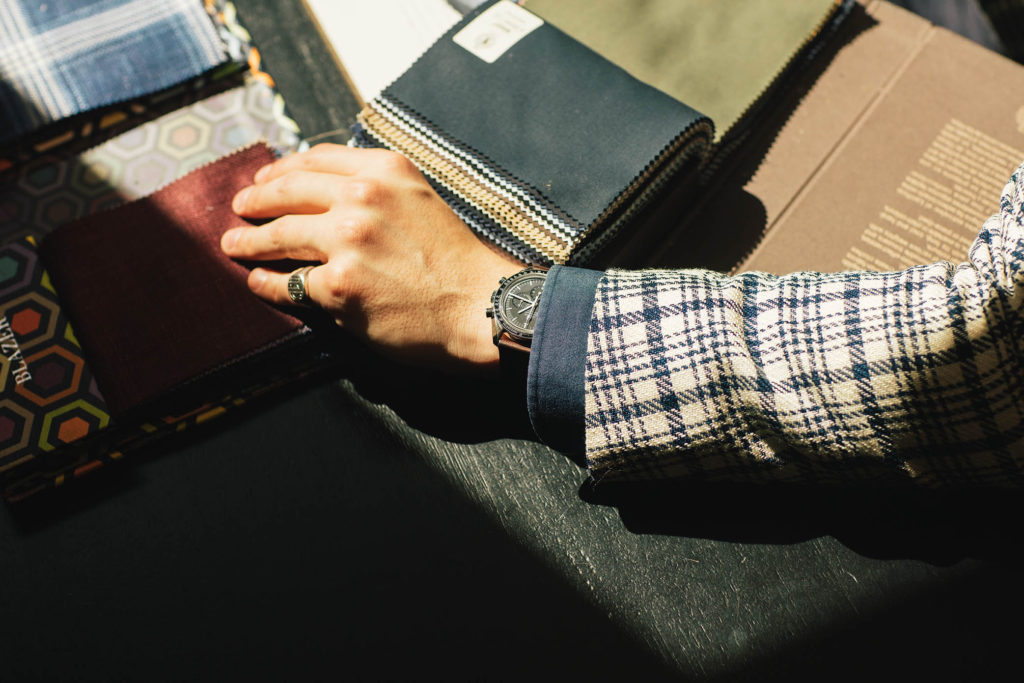Have you ever felt drawn to a piece of clothing simply because of the way the material felt on your skin? Do you wander the racks in clothing stores, enjoying the textures on your trailing fingertips? As creators of custom menswear, we encourage this behavior and experience it daily with our clients.
Good fabric is essential to the construction of a good garment
—and because we’re in the business of creating exceptional suits, our clients get to touch the best fabrics on the planet every single day.
From worsted wool to cashmere, all suit material types have a unique purpose and design. Wool reigns supreme in the suiting world, but there’s almost infinite variety in how wool fibers can be transformed into yarn and woven into fabric. Below, we’ll explore the three main elements that make up a wool fabric, explore some interesting wool varieties, and identify a handful of popular alternative fabrics. After completing this deep dive into suiting materials, you’ll be adept at discerning which fabrics are right for you and your wardrobe.
Wool: The Most Popular Material for a Suit
Wool is the most popular suit material type and this distinction is well deserved. As a natural fiber, wool breathes well and keeps the wearer relatively cool—especially when compared to synthetic fabrics. It’s a sturdy, wrinkle-resistant material that holds its shape well over time and throughout daily use. Because of these benefits, we’re willing to bet every suit-wearing man has a wool suit in his closet.
There are almost as many types of wool as there are men to wear them. Three main variables impact how a wool fabric looks and feels: the diameter of each individual fiber, the way the fibers are blended together, and the weight of the finished material. Here’s what you need to know:
Fiber Diameters
Depending on the way wool yarn is combed or carded, the fibers can change texture. Through the smoothing process, fibers become smaller in overall diameter. Pure wool fibers are given a Super number, which denotes the diameter in micrometers, such as Super 180s or Super 220s. Fabrics with a higher Super number will feel finer, smoother, and more luxurious.
Wool Blends
Other fibers are sometimes blended with wool to create a mixed fabric. Popular wool blends include cashmere, silk, and elastane; these blends make the wool fibers softer, shinier, and more flexible, respectively. Wool blends have grown more sophisticated in recent years. They’re frequently chosen for premium suit construction.
Fabric Weights
The way individual fibers are woven together affects the closeness and porosity of the resulting fabric. A material with an open weave, with ample space left between the fibers, is lightweight and breathable. You might see a fabric like this labeled as 260 g/m (grams per meter), whereas a tightly-woven fabric labeled as 320 g/m has a higher amount of fibers per square meter and will be warm and very insulating.
Identifying Different Types of Wool
When textile manufacturers first combined wool fibers of varying diameters, blends, and weight in creative ways, the resulting fabrics were given unique names that have persisted throughout the years—and sometimes centuries. Each of the following popular materials still falls within the overall category of wool, and each has its own ideal purpose.
Tweed
This traditional fabric hails from Scotland, home of Harris tweed, and Ireland, home of Donegal tweed. Originally created for use in casual outerwear, tweed is made from rough, thick wool fibers in earth tones and is often woven into herringbone and houndstooth patterns. Tweed is a durable and heavyweight fabric, with a density of up to 600 g/m.
Worsted
Worsted wool originated in the English village of Worstead in the twelfth century. It’s made from yarn whose fibers are all combed in the same direction to create an ultra-smooth finish; as a result, worsted wool is the most common material you’ll find on suit labels. Worsted wool is also wrinkle-resistant and will recover its original shape quickly.
Tropical
Generally speaking, lightweight wool fabrics have a density below 250 g/m. Within this category is tropical wool, also known as summer weight wool, which hovers around 200 g/m. These lightweight suit fabrics feature a porous weave, which means they’re breathable and comfortable to wear in warm climates. The downside is that tropical and other lightweight wool fabrics are less sturdy and therefore less durable than fabrics with a higher density.
Superfine
Superfine wool is made from some of the finest fibers available. This fabric is softer, smoother, and more flexible than almost all other kinds of wool, making it perfect for garments that will be worn close to the skin. Blending superfine fibers such as Merino wool culled from Merino sheep or cashmere culled from goats into a wool fabric adds a luxurious softness to the finished suit.
Popular Alternative Suit Fabrics
While many suiting fabrics are made from 100% wool, it’s also common to see wool blended with other fibers, such as silk, Angora, camel hair, or mohair. These blends add a unique feel to the finished garment and help bring variety to the suiting world.
Of course, wool is not your only option for suit material types. One popular material for warm-weather suits is linen, which mixes impressive breathability with an especially light weight. A high-quality linen suit will tend to wrinkle—but the distinctive texture is worth that trouble. When used as a suit fabric, cotton, including the unique seersucker variety, combines lightweight breathability with informal charm. At the opposite end of the spectrum lies velvet, a luxurious high-pile fabric that’s perfect for winter; wearing a velvet blazer will elevate a cold-weather look into something unexpected.
It’s common for lower-quality suits to be made from synthetic fibers.
While synthetic suits tend to be cheap and durable, they drape poorly and lack breathability. Beware of suits made from polyester, viscose, or rayon; even a well-constructed synthetic suit won’t look or feel as good as one made from natural materials. A key exception: Some premium fabrics will blend a small amount of a synthetic fiber, such as elastane, with a greater proportion of wool to provide additional stretch and wrinkle resistance. In very small quantities, this can be a benefit to you, but if the amount of synthetic fibers in a fabric exceeds five percent, avoid it.
Choosing Your Ideal Suit Material
When you’re in the market for a new suit, pay careful attention to the fabric. Now that you’re aware of the wide array of wool varieties and alternatives, you’ll be able to make accurate comparisons and weigh the benefits of each. Need somewhere to start? If you’re looking for an all-purpose classic suiting material, it’s hard to go wrong with a medium-weight worsted wool with a density of around 270 g/m.
To make sure you end up with a suit made from the fabric that works best for you, book an appointment at a Knot Standard showroom to consult with the experts. When you meet with your personal Knot Standard stylist, they’ll answer all your fabric-related questions and show you samples of premium fabrics from world-renowned mills. Together, you and your stylist can decide on the suit material that’s perfect for your lifestyle and craft a custom garment that will make you shine.



